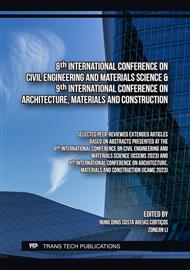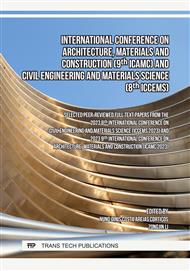[1]
QI De-li,L. J.-l., GE Yun-jian,YU Rong, ZHANG Ren-shun. (2004). Indexes andscale-related fields in ecotourism resources evaluation- Taking Jiangsu coastas an example. JOURNAL OF NATURALRESOURCES, 19(4), 508-518.
Google Scholar
[2]
Ling., Z. (2014). An analysis ofdaylighting rights of buildings in urban construction[J]. Chinese and foreign architecture, 76-77.
Google Scholar
[3]
Jun Wang,M. W., Xiukai Ruan,. (2020). Characterization of the acceptable daylightquality in typical residential buildings in Hong Kong. Building and Environment, 182.
DOI: 10.1016/j.buildenv.2020.107094
Google Scholar
[4]
Peng Xue,C. M. M., H.D. Cheung,. (2014). The effects of daylighting and human behavioron luminous comfort in residential buildings: A questionnaire survey. Building and Environment, 81, 51-59.
DOI: 10.1016/j.buildenv.2014.06.011
Google Scholar
[5]
Ming Lu,J. D. (2019). Dynamic evaluation of daylight availability in a highly-dense Chinese residential area with a cold climate. Energy and Buildings, 193,139-159.
DOI: 10.1016/j.enbuild.2019.03.045
Google Scholar
[6]
Xi Chen,H. Y. (2018). Integrated energy performance optimization of a passively designed high-rise residential building in different climatic zones of China. Applied Energy, 215, 145-158.
DOI: 10.1016/j.apenergy.2018.01.099
Google Scholar
[7]
Lan Lan,K. L. W., Chau Yuen,. (2019). A holistic design approach for residentialnet-zero energy buildings: A case study in Singapore. Sustainable Cities and Society, 50.
DOI: 10.1016/j.scs.2019.101672
Google Scholar
[8]
Weili Sheng, X. K., Bo Wen, Lin Zhang, (2021). Design matters: New insights on optimizing energy consumption for residential buildings. Energy and Buildings, 242.
DOI: 10.1016/j.enbuild.2021.110976
Google Scholar
[9]
Li Yang, Bao-Jie He, Miao Ye, Application research of ECOTECT in residential estate planning, Energy and Buildings, Volume 72, 2014, Pages 195-202, ISSN 0378-7788.
DOI: 10.1016/j.enbuild.2013.12.040
Google Scholar
[10]
NadeekaJayaweera, U. R., Inoka Manthilake,. (2021). A parametric approach to optimizesolar access for energy efficiency in high-rise residential buildings in denseurban tropics. Solar Energy, 220, 187-203.
DOI: 10.1016/j.solener.2021.02.054
Google Scholar
[11]
AsimAhmad, A. K., Om Prakash, Ankish Aman, (2020). Daylight availabilityassessment and the application of energy simulation software – A literaturereview. Materials Science for Energy Technologies, 3, 679-689.
DOI: 10.1016/j.mset.2020.07.002
Google Scholar
[12]
Olufolahan Oduyemi, Michael Okoroh, Building performance modelling for sustainable building design, International Journal of Sustainable Built Environment, Volume 5, Issue 2, 2016, Pages 461-469, ISSN 2212-6090.
DOI: 10.1016/j.ijsbe.2016.05.004
Google Scholar
[13]
Anne de Bortoli, Yacine Baouch, Mustapha Masdan, BIM can help decarbonize the construction sector: Primary life cycle evidence from pavement management systems, Journal of Cleaner Production, Volume 391, 2023, 136056, ISSN 0959-6526, https://doi.org/.
DOI: 10.1016/j.jclepro.2023.136056
Google Scholar
[14]
Guang chong Chen, Zixuan Yan, Jiayu Chen, Qiming Li, Building information modeling (BIM) outsourcing decisions of contractors in the construction industry: Constructing and validating a conceptual model, Developments in the Built Environment, Volume 12, 2022, 100090, ISSN 2666-1659.
DOI: 10.1016/j.dibe.2022.100090
Google Scholar
[15]
Challinger, D. (2008). Crisp Report From the Ground UP Security for Tall Buildings Pamphlet ASIS.
Google Scholar
[16]
Encyclopedia, W. (January 16, 2009). High-rise. Retrieved January 5 from http://en.wikipedia.org/wiki/High-rise building
Google Scholar
[17]
JR, H. J. (September 2013). High-Rise Building Fires. NFPA Fire Analysis & Research, Quincy, MA.
Google Scholar
[18]
Walker, L. (1998). American Shelter: An Illustrated Encyclopedia of the American Home (Vol. 1998). Overlook Press.
Google Scholar
[19]
Song Xiaodong, S. C. (2004). Exploring themethod of estimating building floor area ratio under the constraints ofsunlight standards. Journal of UrbanPlanning.
Google Scholar
[20]
Shenzhen Institute of Building Research. (2004). Training materials for the Shenzhen Code for Energy-saving Design of Residential Buildings. Shenzhen Municipal Housing and Construction Bureau.
Google Scholar



